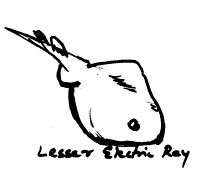Prashant Mahajan
CEC, BNHS, Mumbai
 These are the highly specialized species, which are capable of producing electricity in their bodies,
and are thus unique in the animal kingdom. For this power-generation they possess electric organs which consist of a group of hexagonal muscular tissues separated by fibrous ones which are connected by sensitive nerve endings serving as positive and negative
poles at opposite ends. These muscles on stimulation by nerves create electric charges which can be measured and vary from 60 to 220 volts, or even more in some cases. They are used for stunning the prey or driving away enemies. Man also sometimes becomes
a victim if he happens to touch the fish.
These are the highly specialized species, which are capable of producing electricity in their bodies,
and are thus unique in the animal kingdom. For this power-generation they possess electric organs which consist of a group of hexagonal muscular tissues separated by fibrous ones which are connected by sensitive nerve endings serving as positive and negative
poles at opposite ends. These muscles on stimulation by nerves create electric charges which can be measured and vary from 60 to 220 volts, or even more in some cases. They are used for stunning the prey or driving away enemies. Man also sometimes becomes
a victim if he happens to touch the fish.
In another type of electric generation, low-frequency fields are created around the body for recognizing
the mate in muddy waters as well as for sensing the approach of enemies or obstructions in the neighborhood. The electric eel and catfish of the Amazon River are capable of lighting small electric bulbs! In Indian waters the small ray fishes are known for
their capacity to administer electric shocks of low intensity. They have their electric organs situated on both sides of their backbone, behind the gill slits. In the specialized Stargazers, who remain hidden in the mud with only eyes and mouth protruding
above also are capable of giving electric shocks, these muscles are situated near the eyes in the head region. All these fishes inhabit the muddy coastal waters of both coasts and sometimes startle fishermen by their shocks.
The electric ray (Torpedo, Narcine) is found in Indian sea. It has an organ made up of modified muscles, which produces an electric current that can shun it's prey
or ward off it's enemies. P.S
The electric ray has attracted considerable amount of research in the West, but apparently little or no work has been done on this marine animal by Indian scientists.
Click for pictures of electric rays